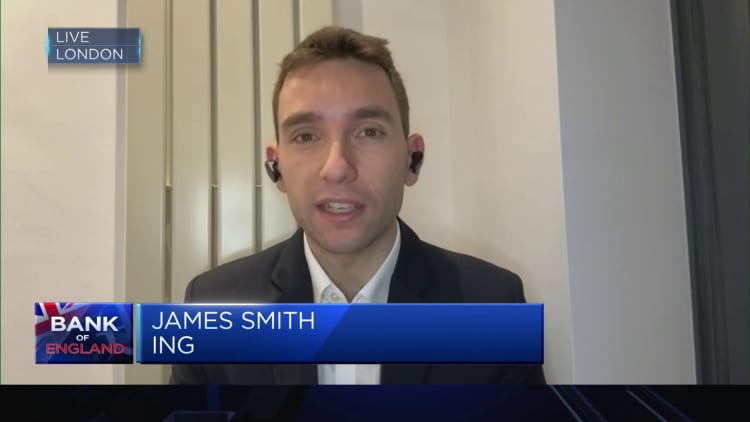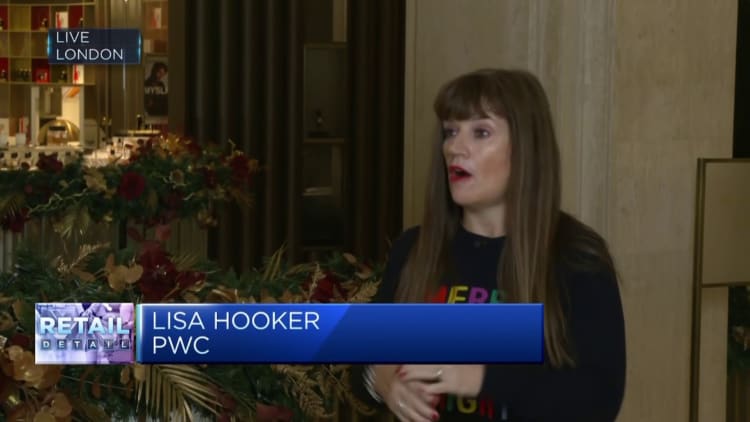A passageway near the Bank of England (BOE) in the City of London, U.K., on Thursday, March 18, 2021.
Hollie Adams | Bloomberg | Getty Images
LONDON — The Bank of England is all but certain to keep its main interest rate unchanged at 5.25% for a third consecutive meeting on Thursday, but economists are split over when to expect the first cut next year.
The market is pricing an almost 100% chance of a hold on Thursday, according to LSEG, with economic data since the Bank’s last meeting proving largely inconclusive.
Real GDP was flat in the third quarter, in line with the Monetary Policy Committee’s projections, while both inflation and wage growth have undershot expectations and domestic demand has been weak. U.K. headline inflation fell to an annual 4.6% in October, its lowest in two years.
The latest labor market data on Tuesday indicated a continuation of recent trends, with unemployment remaining broadly flat and vacancies continuing to reject at pace.
“This fits the hypothesis of some U.S. Federal Reserve officials that, with vacancies so high, it may be possible to unveil slack into the labour market without significantly raising unemployment,” PwC Economist Jake Finney said in an email Tuesday.
Average pay including bonuses fell by 1.6% between September and October, versus an average monthly growth rate of 1.1% in the first half of the year.

Finney noted that real inflation-adjusted wages are still growing on a year-on-year basis due to a steep fall in headline inflation, suggesting the worst of the country’s cost of living crisis is behind the average household.
Signs of the labor market cooling will offer some reassurance to the MPC ahead of Thursday’s meeting, Finney said, especially given the lack of major surprises in the economic data over the past month.
U.K. GDP shrank by 0.3% in October, new figures showed Wednesday, well below the flat reading expected by economists polled by Reuters and erasing the 0.2% growth recorded in September.
Multiple analysts suggested subsequently that the negative growth figures would cement Thursday’s expected hold on rates, but could enhance the likelihood of cuts sooner in 2024 as the Bank looks to avoid tipping the economy into recession.
Rhetoric to remain hawkish
In light of this, Barclays expects the MPC to deliver a split vote in favor of a hold, but keep its rhetoric hawkish as it pushes back against the market’s pricing of “premature” cuts. Barclays does not expect rates to fall until August 2024.
Economists at the bank, Abbas Khan and Jack Meaning, said they expect the MPC to continue to suggest that its current monetary policy stance is “restrictive,” with growing signs of its impact on activity and the labor market.
“An unchanged forward guidance will also serve the MPC well to push against the current market pricing of Bank Rate which assigns an increasing probability to cuts in H1 2024,” they said.

“We continue to expect the beginning of the cutting cycle in August 2024 and a terminal Bank Rate at 3.25% by Q2 2025.”
Khan and Meaning added that a repricing of the timing and magnitude of cuts by the U.S. Federal Reserve and the European Central Bank, both of which will also announce policy decisions this week, may exert pressure on the MPC to start cutting the Bank rate earlier if sterling was to spike and cause inflation to fall below the Bank’s 2% target sooner or by a greater margin.
“However, given the timing of data cycles, the level of inflation, in particular in services, and the y/y rate of wage growth, we think it is unlikely that the MPC will pivot in H1 2024 and almost certainly not before May,” they added.
No change in narrative
Both the Fed and the ECB have seen their hawkish stances tempered by dovish interventions from pivotal voting committee members — Christopher Waller in the U.S. and Isabel Schnabel in Europe.
By contrast, the Bank of England’s centrist policymakers, such as Governor Andrew Bailey and Chief Economist Huw Pill, have repeatedly emphasized that it is too soon to talk about cuts, while more hawkish members have raised advance concerns about the potential persistence of inflationary pressures.
“While current market pricing is not too far away from our Bank Rate forecast — first cut in June and 100bp of cuts over 2024 — at this stage we think that the BoE will want to impede financial conditions loosening too much, too soon,” BNP Paribas European economists Paul Hollingsworth and Matthew Swannell said in a research note last week.
The French bank expects the Bank of England to reiterate the need to remain in restrictive territory on Thursday, though as there will be no press conference or updated projections, this will need to be conveyed through the vote split, guidance and any post-meeting communications.
“Ultimately, however, we expect both growth and inflation to be weaker than the BoE forecasts for H1 2024, bringing a first cut in June 2024 and taking Bank Rate to 4.25% by the end of the year,” Hollingsworth and Swannell added.



